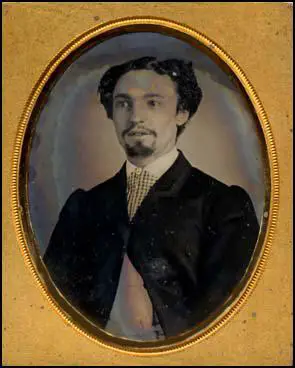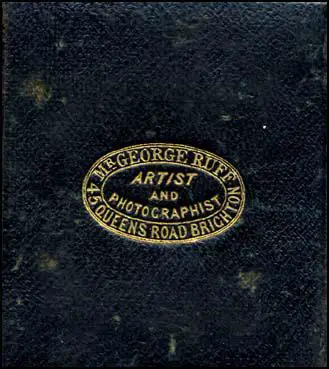Collodion
Positives - Cheap Portraits on Glass
Frederick Scott Archer's collodion 'wet plate' process produced
a glass negative which could make an unlimited number of prints
on paper. However, most customers were seeking a cheap alternative
to the handsome daguerreotype portrait, which came protected under
glass in a metal frame and presented in a velvet-lined, leather-bound
display case. Scott Archer soon realised that by underexposing
the collodion glass negative and placing it on a black background,
the image took on the appearance of a positive picture.The resulting
image was as sharp and clear as a daguerreotype, yet Archer's
new process was cheaper and less complicated. Furthermore, the
collodion positive process was incredibly quick to perform.
Photographers could see immediately the commercial possibilities
of a cheap and speedy method of taking portraits. The "collodion
positive" photograph on glass could be backed with black
paper, very dark varnish or provided with a background of black
velvet or similar dark cloth. Protected by glass, placed in a
metal frame and inserted in a presentation case or an elaborate
frame, the collodion positive was an inexpensive substitute for
the daguerreotype portrait, which in the 1840s had been the preserve
of the nobility and the wealthy middle classes of society.


A
Portrait of a Bearded Man. A collodion positive photograph on
glass taken by George Ruff senior (c1858). The presentation case
is similar to the ones that held daguerreotype portraits.
William Lane of Brighton was promoting the new process of making
"portraits and views taken on glass" as early as September
1852. In an advertisement placed in The Times, dated 10th September
1852, Lane claimed that "any person can produce in a few
seconds, at a trifling expense, truly life-like portraits."Early
in 1853, William Lane's Cheap Photographic Depot was offering
a "complete set of apparatus for the glass or paper process"
for the sum of 4 guineas (£4. 4s/£4.20p). By October
1853, The Royal Chain Pier Photographic Rooms in Brighton
were advertising "Portraits superior to engravings by the
new process on glass."
On 3rd August 1854, Grey & Hall's Photographic Institution
on St James Street announced they had "completed arrangements
for taking portraits by all the most recent and improved processes,
by License of the Patentees". In addition to Talbotype portraits
and "Daguerreotypes warranted to last," Grey and
Hall offered to make "Coloured Collodion Positives by
a new and peculiar process" for the sum of 15 shillings (75p).
Stephen Grey and William Hall were keen to emphasize
that their new methods of taking portraits were "licensed
by the Patentees". Archer had not patented his invention
and Beard's daguerreotype patent had expired the year before,
but William Henry Fox Talbot claimed that the "collodion
process" was covered by his earlier patent which had described
a negative/positive system of photography.
In 1854, W.H.Fox Talbot took legal action against the studio of
Silvester Laroche,the professional name of Martin Laroche, a London
photographer who had started to use Archer's "wet collodion"
technique in 1853. Silvester Laroche went to court to defend his
right to use the "wet plate" process. In December 1854,
Laroche was found not guilty of infringing Talbot's patent rights
and as a result of this legal judgement all photography was now
free from restriction.
In the summer of 1855, James Henderson, a photographic
artist who had previously operated portrait studios in London's
Strand and Regent Street, opened a photographic studio at No 5,
Colonnade in New Road, Brighton. In an advertisement dated 4th
August 1855, James Henderson offered to take "Photographic
Portraits, on Paper, Silver, and Glass Plates . . . Prices from
10s 6d and upwards." In this newspaper advertisement, Henderson
"begs to remind all lovers of Photography that he has been
at considerable expense in defending the freedom of this beautiful
art against Mr Fox Talbot, the Patentee of the Talbotype process."
Earlier, in May 1854, Talbot had obtained an injunction which
restrained Henderson from making and selling photographic portraits
by the collodion process. Laroche's successful defence against
Talbot's legal action meant that Henderson and other photographers
in Brighton were free to produce portraits using any of the main
photographic processes.
CLICK HERE TO CONTINUEA
Variety of Photographers The Artist- Photographer,Chemists,
etc